by Lisha Vidler
In this two-part article, we’ve been exploring the myths surrounding corsets. First, we looked at what corsets were designed for, and then we looked at the myths of minuscule waists, and whether or not women actually removed their ribs for the sake of a smaller waist. Now let’s examine four more myths about corsets.
Myth: Painful and Restrictive
Many historical romance novels feature characters with modern feminine ideals, women born into the wrong time, who assert their independence by casting away the dreadful inhibitions of their corsets. We’ve all seen the films where the independent heroine complains about her corset. “I can’t breathe!” she declares. “Who needs this dratted thing, anyway?”
Does this reflect reality? While there are times when a woman’s corset might feel uncomfortable—especially if it’s been laced too tight—the truth is, a well-fitted corset is generally no more painful than a modern underwire bra. In fact, some well-endowed women claim that they’d rather wear a corset than a bra, because it supports the bust from underneath, rather than allowing the weight of a large bosom to be suspended entirely from the shoulders.
Note, the key phrase here is well-fitted. A corset is designed to fit its wearer like a glove. It must be made for you, and you alone, in order to be comfortable. It’s important that the corset fit, not just around the bust, waist, and hips, but in length as well.
A properly fitted corset is designed to fit snugly, but not tight. After all, it isn’t the ribcage that’s meant to be compressed, but the fatty tissue of the waist. When the Victorian corset is laced, it squishes the fat downward into the abdomen where it won’t show. This is what allows a woman to achieve a smaller waist size than normal. If you are muscular or bony, you’ll have less to squish and will probably get little shaping from wearing a corset. There are exceptions to this rule, however. Some women who thought they were too skinny for a corset to do any good have ended up with miraculous curves—by experimenting and finding just the right cut of corset for their body.
Of course, this isn’t to say that wearing a corset doesn’t take getting used to. Victorian girls wore lightly-boned training corsets to accustom them to the enforced posture. And Victorian women knew better than to try and achieve a small waist quickly. They tightened their corsets slowly, over the course of the day, so that by evening, they might have the smallest possible waist. Modern women may well find a corset restrictive at first, especially if they try to lace it too tightly. In time, though, provided your corset fits well and is worn properly—that is, not tight but merely snug—you should be able to walk, run, sit, kneel, dance, sing, and even roll around on the ground without difficulty.
You won’t be able to bend much at the waist, however, and this is where much of the concern about corsets being restrictive comes in. Steel corset boning is flexible, but it does prevent you from bending very far. Interestingly, modern doctors recommend that you don’t bend from the waist when picking things up from the ground, but rather kneel with your back straight. Thus, wearing a corset actually encourages good posture and movement.
Now lets look at two more corset legends: the Hollywood image of women fainting or even dying because of their corsets, and the idea that women were unable to dress themselves.
Myth: Fainting, Swooning, & Dying
What of the heroine who gasps dramatically, then swoons into her lover’s arms? Is her corset responsible?
In truth, women did occasionally faint or pass out. In most cases, it was due to extenuating circumstances—an underlying health condition, overexertion, over-excitement, or overeating while wearing a corset that was laced too tight. In some cases, a woman might faint from having deliberately tightened her corset beyond what was reasonable. Then, as now, women wanted to look their best for special occasions. A modern woman might pull out the Spanx®, or she might diet prior to the big event, just to ensure that she looks as slender as possible. Women of the past were no different, but instead of wearing control-top pantyhose, they would simply lace their corsets a little tighter than usual. Combine that with an evening of rich foods and dancing, and it’s no wonder the smelling salts were occasionally necessary!
What of modern actresses who don corsets for roles in period films? There have been many interviews given where an actress talks about how she got lightheaded, or was simply in agony from so many hours laced into a corset. Some of these complaints may be exaggerated for the sake of an exciting interview, to generate interest in the upcoming film, or to highlight the sacrifices made for the sake of art. Some complaints are legitimate, though—and you may well wonder, why are these actresses in so much discomfort?
Consider that many period films rent their costumes from warehouses rather than having garments custom made for their actresses. This means the costumes won’t necessarily fit well, and remember—for a corset, proper fit is essential. Even when the costumes are custom made, the dressmakers often have to produce a great many costumes under a tight deadline. They simply don’t have the time to perfect the fit on an undergarment that might not even be seen on camera.
Add to that simple ignorance of how corsets were meant to be worn, and the pressure of needing the actress to look her absolute best—you end up with someone lacing the actress too tight, and it’s no wonder she then complains of being uncomfortable.
If fitted well and worn correctly, however, corsets are perfectly safe. That is, when worn snugly, but not tight. Many reenactors wear corsets on a daily basis, and very few have ever passed out.
Myth: Deformation
What of claims that corsets permanently reshape your body, and crush your internal organs, causing dangerous compression?
If you wear restrictive garments for long periods of time, they will shape your body. This is true even of modern clothing: witness the dips many women have on the tops of their shoulders from too-tight bra straps, or the muffin top that develops when a woman consistently wears snug low-rise jeans. This is a simple redistribution of fatty tissue, and is harmless, if aesthetically displeasing.
It’s true that a corset does apply pressure to your torso and may shift your internal organs somewhat. Your viscera are basically floating in a sac of fluid and are easily moved about. The danger lies in compressing them to the point where digestion is hindered and blood flow restricted. This can be caused by tight-lacing: a risky activity that a few still practice today. Moderate corset-wearing, however, poses little danger.
What of claims by Victorian doctors that corsets caused all manner of dangerous ailments? These ranged from indigestion to hysteria, and even death! Keep in mind, however, that these same doctors sold patent medicines containing poisonous ingredients, and they declared that warts and blindness would occur if young ladies touched themselves in a sinful way—something that is patently untrue. While well-meaning, their claims were largely unsubstantiated and, on occasion, outright lies.
Myth: Unable to Dress Yourself
Many times I’ve heard it claimed that only wealthy women wore corsets, because they needed a maid to assist them in dressing. Women of the lower classes couldn’t afford personal maids. Did this mean they couldn’t wear corsets?
First, consider what it would mean for a woman to go in public without a corset. Corsets were the historic equivalent of the bra. They were designed to support the breasts, something that most women realize is an absolute necessity. An historic woman going without a corset would be the same as a modern woman going without a bra. At best, it would be shocking, and at worst, the woman in question would be considered “loose”, immoral, and unwholesome.
Granted, some women do get away with not wearing a bra today, and it seems logical that a few did back then, too—particularly small-breasted women who don’t experience discomfort when leaving their bosoms unsupported. Today, a less-endowed woman might be able to appear in public without it being obvious that she’s without a bra; in the past, however, it would be instantly noticeable if a woman went without a corset: her posture would be different, her clothes would wrinkle and appear ill-fitting, and her silhouette would vary from the “norm”.
Could a woman, whether wealthy or poor, put on a corset by herself? Absolutely! Unless she had arthritis or some other malady that made reaching behind her difficult, there’s no reason she couldn’t lace her own corset. Of course, it’s always easier to dress with someone else’s help, if it’s available, but the only time a woman would require assistance would be if she wore a corset that had no front closure—like some from the 17th and 18th centuries.
Many extant corsets from those periods have been found that lace in both the front and back, an innovative feature that allowed a woman to dress herself. In the 1850s, the two-piece metal busk became popular, which made dressing alone much easier. To further support the concept of women dressing themselves, there are period examples of art that illustrate this.
Conclusion
We’ve looked at many of the myths surrounding corsets today. We examined the true purpose of the corset: what it does, and more importantly, what it does not do. We’ve learned that it’s not intended to make a woman’s waist impossibly tiny, nor is it meant to be painful and restrictive. If worn properly, it does not dangerously deform, nor does it cause fainting, swooning, or sudden death. Women could dress themselves easily and corsets were not limited to the wealthy.
Therefore, wear your corset with confidence and good health!
For further reading, I highly recommend the following books.
- The Corset and Crinoline: An Illustrated History by W. B. Lord
- The History of Underclothes by C. Willett Cunnington
- Underwear: Fashion in Detail by Eleri Lynn
~~*~~
What does wearing a corset mean to you? Does it symbolize the ultimate femininity, or entrapment and loss of freedom? Have you heard any costuming rumors you’d like verified, or myths you’d like dispelled?

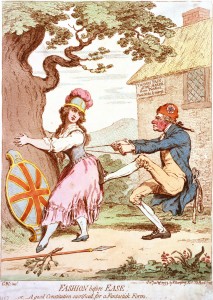
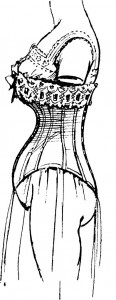
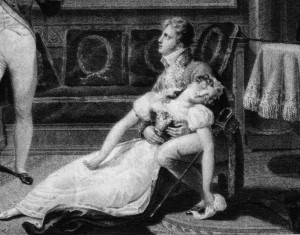
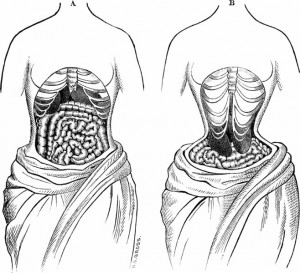
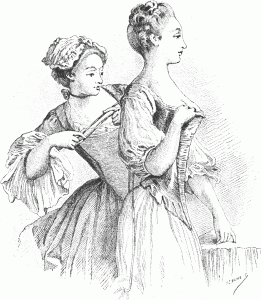
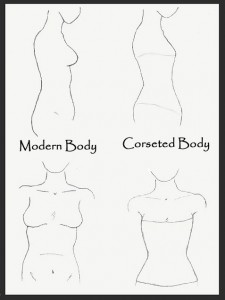
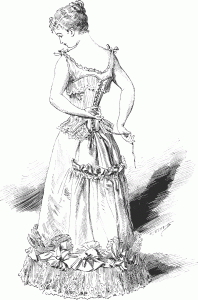
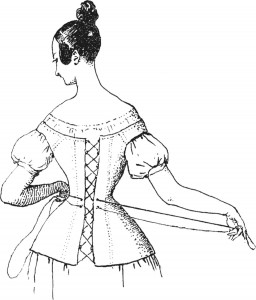
I’m in a hurry to go at this moment but I am wondering is there was way by using the corset without damaging the ribcage by getting an hourglass figure. What is the correct height and weight to get an hourglass figure while wearing the corset for a safe waist and no ribcage modification?
I could be wrong, but I believe most corsets apply pressure to your lower ribs. This is generally considered safe, because your lower ribs are very flexible. When the corset is laced correctly, the upper ribs are not compressed, only your lower ribs and waist area, and even that is not meant to be tightly squeezed, only to have a snug fit. It’s not so much height and weight that enables you to get an hourglass shape with a corset, but rather the cut of the corset itself, and your body type. If you’re lean and muscular, you might find it harder to achieve a small waist. But if you have a lot of “squish” in your waist (i.e.: fatty tissue), it will be easier to get that hourglass shape, because the corset can shift excess fat down toward your belly, giving you a smaller waist. I would suggest trying different types of corsets to see which one works best for you. The message board at TrulyVictorian.com is a good place to ask about which specific corset might work for your shape. If you plan to sew your own corset, I highly recommend the corset-making articles at FoundationsRevealed.com. (It’s a paid subscription site, but several articles are free.) I hope this helps!
Where is a good place to find well-made, affordable corsets with lots of different types? My friend is getting engaged soon and he wants to start helping his girl find a good corset for the wedding if she wants one. She’s kinda muscular because she’s a rock climber but still has some curves… Someplace in LA would be best but I know he would drive all the way to San Deigo to get his girl a comfortable corset.
Thank you, Lisha, for two very interesting and informative posts on corset myths. I agree that there is a lot of rubbish written about corsets, and the net seems to transmit some of the worst of it!
It’s very interesting that you look at corsets from the sewing dimension, my interest starts in social history and social values – we meet in the middle. May I make a few comments?
1. Yes, our views today on bras reflect the same attitudes as many 18 and 19 century women had on their stays or corsets. We might complain about our bras at the end of the day, but many of us would not be seen dead in public without a bra – too much wobble, nipples showing, and sending the wrong message.
2. It’s interesting that in the 1950s and early 1960 bras were seen as “healthy” and “necessary” – some beauty experts and doctors recommended wearing a bra at night. Today we have the message that bras might be a danger to health. I’ve also seen news that some doctors are worrying about the long term effect of teenage girls wearing super uplift bras (Wonder bra etc) everyday.
3. Posture and deportment were the signs of a well brought up lady. My opinion is that you cannot hold yourself for very long in the required posture without a good corset!
4. Many 18/19 women wrote that they found corsets uncomfortable, especially for when dressed for special occasions. As it was normal for girls to wear corsets from a young age (yes, you can find corsets for babies and upwards on the web!), there are genuine first hand accounts of teenage girls suffering in corsets. We must remember that until recently pain and being uncomfortable were acceptable and had to be accepted!
5. Yes, I agree with Lisha, many of our clothes change the shape of our bodies, sometimes permanently. High-heeled shoes, back combing hair, girdles, stockings etc all change us in some way. I remember wearing a tight long line bra for 2 weeks in the 1960s, and that changed my posture and breathing.
Let’s have corset myths number 3 please!
Mary
Thank you for your comments! It’s nice to see that I’m not alone in my viewpoint about corsets. I’m sorry your comment took so long to post–it failed to inform me that it was waiting for moderation. I only discovered it by accident this evening!
When you mention first hand accounts of teenage girls suffering in corsets, are you talking about letters to the editor of a short living domestic magazine/newspaper? Because they’re not believed to be written by teenage girls but by men in a fetish community – possibly the publisher of the magazine himself.
Where might one get a corset custom made? I ask because you seem to have a very good opinion concerning corsets and I’d like to know what you think. Either specific stores or suggestions of a type of store are welcome.
To get a custom-made corset, you’re going to need a dressmaker who specializes in corsetry. Google the phrase “Custom Corset” and you’ll find a number of websites for people who make and sell corsets. I don’t have experience with any of them, so I can’t recommend one, but I’m sure you’ll find someone who can work with you. I hope you find what you’re looking for!
I realize I’m a bit late to the game. But, I got my custom under bust from Contessa Gothique. She was recommended to me by Lucy’s Corsets. She is a lovely affordable corsetierre from Croatia. I’m very happy with what she made for me, her honesty, how she kept in touch, and her process.
I have a large muffin top due to 8 surgeries on my stomach and being 35 lbs overweight , I love wearing corsets though. They make the whole muffin top look even worse. Any suggestions on how I could minimize the muffin top by wearing a corset?
Getting a corset custom-made for you is your best bet. You need a designer who knows what they’re doing, as your corset will probably need some modifications to fit properly. It will need to fit snugly, but NOT TIGHT around the bust. There must be adequate space within the corset’s bust to allow any excess tissue to settle downward. The way a corset works is by distributing fat and tissue elsewhere. Most Victorian corsets are loose in the hips and belly, because once you squeeze the waist in, all that tissue has to shift downward. The key, however, is to not lace the corset too tightly. If you lace so tight that the tissue has nowhere to go, then it’s going to spill beyond the confines of the corset, creating muffin top hips, excess boobage, back cleavage, and so forth. This is one reason I always stress: don’t lace your corset too tight. It’s meant to be snug, only. And it absolutely must fit properly, otherwise you’re going to end up with the above-mentioned spillage, along with it being uncomfortable.
If you sew and want to make your own corsets, visit FoundationsRevealed.com, it’s a subscription site filled with how-to articles and wonderful advice on how to get your corset to fit. Worth every penny! Plus, they have some free articles, too. Another good resource is TrulyVictorian.com. Visit their forums and submit some photos, and they can help you figure out what steps you need to take to make your corset fit better. I hope you’re able to find a solution! There’s nothing in the world like a well-fitting corset.
You could try wearing a corset liner to smooth everything out before you put on your corset or wear spanx over the corset to smooth everything out afterwards. I’ve heard of both being done by women wearing corsets with more modern styles.
Before the industrial revolution corsets were too expensive for the un-well-to-do. Ordinary women did not wear support garments under their clothes. It was the industrial revolution in its early years that made cosets affordable by the middle and upper lower classes. Once they were available to women of modest means, the corset makers and sellers could insult women who did not want a corset by calling them “loose,” literally that their breasts were free to move, but inferring that they were immoral. So women, who did not want to be thought morally loose, did their best at getting the money for a corset.
The same trick was used to get women to buy razors to shave their legs and armpits: infer that women with bushy armpits and hairy legs were mannish and trashy. All to market safety razors and blades!
Thanks for commenting! Can you share your sources to back up your claim that corsets were unavailable to lower-class women? I’ve seen museum examples and patterns for “working-class” stays, as well as extant paintings and portraits showing lower-class women wearing stays, so I know corsets were widely available during the 18th century. Earlier than that, I’m not sure, as my area of expertise is limited to the 18th and 19th centuries. However, everything I’ve read suggests that even lower-class women weren’t exempt from propriety, so they would have worn proper undergarments, unless they were living in total poverty. If you have proof that says otherwise, I’d love to read it! I’m always interested in learning new details about the history of fashion.
I’ve read that often working class women relieved discarded stays/corsets by the rich and that there was a thriving second hand market. The second hand clothing then though had much more stigma against it than today it seems. It also seems there was once a lot more pressure put on people to appear as better off as they could afford.
Would you possibly be able to give me an approximate age of a corset? Tag says: “Individually designed, Spencer, New Haven, Conn. Made under one or more of these U.S. Pats. 2.372.034 – 2.494.216, 2.205.771 – 2.772.417.”
Any information would be appreciated! Would like to figure out who in my family history it might have belonged to.
I tried searching for the patent information via Google Patents (http://www.google.com/patents). I only found one corset by a man named Darwin Spencer Berger in New Haven. It was from 1910, but without seeing your corset, I couldn’t say whether it’s similar or not. If you sent me a couple of photos, showing the shape of the corset from the front and from the side, I might be able to narrow down which decade it’s from. The problem is, corsets didn’t change much throughout recent history, not the way dresses did. A corset from the 1870s is very much like a corset from the 1890s, even though fashions and silhouettes changed drastically during those years. I’m not an expert on identifying extent undergarments–at best, I could maybe tell you what decade it’s from. Sorry I couldn’t be of more help, but if you want to send me some pictures, just let me know and I’ll email you privately.
Company info: Spencer Corset Co., Inc.,133 Derby Ave, New Haven Conn.
Pre-WWII maker. Patent numbers date it precisely with design dating to 1940 and revised through 1956. The latter date would be the maximum vintage of your particular corset, as a 1956 patent would not be cited prior to it being issued.
A search will reveal many WWII era advertisements in LIFE Magazine and other periodicals.
Very interesting! Corsets should be comfortable to wear)
Hi Lisha,
Great article! I’m currently working on my school’s history project. We are examining the then and now of the industrial revolution. I decided to talk about women’s fashion and focus specifically on corsets. How did the industrial revolution affect women’s corsets? (ex:Were they cheaper because they started to make them in factories?) If you can answer me, that would be terrific! Thank you!
I loved reading your articles! I’ve always thought that the negative aspects of corsets were exaggerated. But can you please answer on why corsets needed to be laced in the first place? I don’t see why they couldn’t have been unlaced and just made in certain shapes for the sake of fashion. Why did they need to be used for developing smaller waists? Especially for actresses having laced corsets, that’s confusing to me.
I may be wrong as I’m not that knowledgable in this area and I’m just guessing based on my minimal research. I’d love to know if anyone has any other theories. Corsets, it seems to me, started out life as a skirt-less boned kirtle towards the end of the Renaissance called a payre of bodies. There were very few closure methods then. It seems that kirtles were laced and so the first stays were too. Upon the invention of the metal busk, the lacing just remained. It seemed to be simply because it worked and that’s how they always did it.
Pingback: Let’s Talk About Our Underwear ░ CloudyApples | CPU 5D
Pingback: Improving Theatrical Costumes, Part 1 – Your Ward